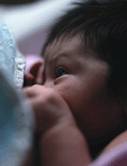
MONDAY, Dec. 1, 2014 (HealthDay News) — Although soft bedding has been linked to an increased risk of sudden infant death syndrome (SIDS), more than half of American parents continue to use such bedding for their sleeping babies, according to a new study.
Use of soft bedding among parents declined sharply from 1993 through 2000, but has mostly leveled off since the early 2000s, the study found. The American Academy of Pediatrics has recommended since 1996 that infants be placed in sleeping environments without any soft surfaces or objects that might trap air, the study noted.
“Soft bedding has been shown to increase the risk of SIDS. Soft objects and loose bedding — such as thick blankets, quilts and pillows — can obstruct an infant’s airway and impose suffocation risk,” said lead author Carrie Shapiro-Mendoza, a senior scientist in the Maternal and Infant Health Branch of the U.S. Centers for Disease Control and Prevention.
About 16 babies per 100,000 died from accidental suffocation during sleep and 53 per 100,000 died from SIDS in 2010, according to background information in the study.
The researchers analyzed the results of the National Infant Sleep Position survey. This poll was conducted by phone annually between 1993 and 2010. Over that time, nearly 19,000 parents of children younger than 8 months answered questions about their baby’s sleep environment. Most respondents were white mothers, nearly half had a college education, and about half had a previous child, according to the study.
The researchers found that the use of bedding for infants declined from an average of 86 percent between 1993 and 1995 to an average of 55 percent between 2008 and 2010. Most of that decline, however, occurred before 2000.
The findings were reported online Dec. 1 in Pediatrics.
The most common use of bedding occurred among teen mothers, more than 80 percent of whom used bedding. Not having a college education and younger mothers in general were also linked to more frequent use of bedding. Minority mothers were more likely than white mothers to use soft bedding, the study reported.
About 70 percent of the infants sleeping with soft bedding were on adult beds and/or sharing a sleeping surface with someone else, the researchers found.
The most common type of bedding covers used were thick blankets, used by just over a third of parents, and quilts or comforters, which about one in five parents used. But the use of thick blankets and quilts or comforters dropped significantly between 1993-1995 and 2008-2010, according to the study.
Research shows that infants who die from SIDS are found more often with bedding over their heads than similarly aged infants who don’t die from SIDS, said Peter Blair, a medical statistics researcher in infant and child health at the University of Bristol in England. “Some infant deaths, especially in the prone position, occur when the infant is face down on a pillow or soft toy,” he said.
Yet the survey showed that many still use bedding under sleeping infants as well. Use of blankets under sleeping babies increased from 26 percent to 32 percent and pillow/cushion use under infants slightly increased as well, from 3 percent to 5 percent.
“Babies should sleep on a firm, safety-approved mattress with a fitted sheet, without any other bedding,” Shapiro-Mendoza said. “Also important when placing the infant to sleep in a crib or bassinet is placing the infant on his or her back and not sharing a sleep surface with the infant.”
This study did not assess the use of crib bumpers or infant sleep positioners, but these items — even those marketed as supposedly reducing the risk of SIDS — are also potentially hazardous in the sleep environment, according to both experts.
“Perhaps one of the reasons this problem still persists is that the SIDS risk reduction campaign has less money to spend advising against these items than advertising industries have promoting them,” Blair said.
Parents may also believe soft bedding has benefits for their babies, and images in popular magazines often show babies sleeping with blankets and pillows, Shapiro-Mendoza said.
“Seeing these images may reinforce beliefs and perceptions that having these items in the infant sleep area is favorable and the norm,” Shapiro-Mendoza said. “Studies suggest that parents use soft bedding to provide warmth, comfort and perceived safety.”
For example, she said, parents might use pillows as a barricade to prevent falls from a sofa, but sofas are not safe sleeping surfaces for babies.
“The safest place for a baby to sleep is on his back, in a crib or bassinet in the parent’s or caregiver’s room,” Shapiro-Mendoza said.
More information
Learn more about sudden infant death syndrome from the U.S. Centers for Disease Control and Prevention.
Copyright © 2025 HealthDay. All rights reserved.

